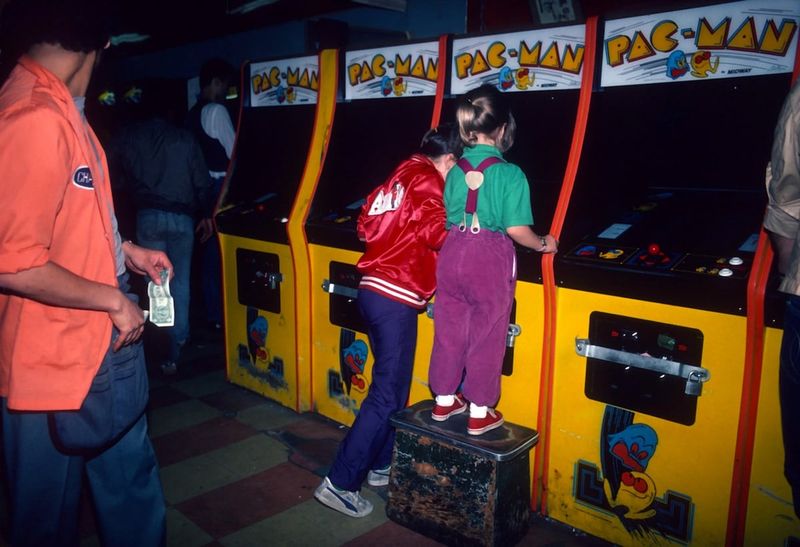For Generation Z, the childhoods of Generation X often seem starkly different and, at times, notably lacking compared to today’s standards. Here are fourteen reasons why Gen Z might view Gen X’s formative years as rather melancholic.
1. No Internet

Imagine a world where information isn’t at your fingertips. For Gen X, the Internet, as we know it, was non-existent. Research for school meant trips to the library and going through dusty encyclopedias.
Ask a Gen Xer what they did for fun, and stories of playing outside until dusk emerge. With no smartphones to distract, creativity was key.
Yet, many find it hard to comprehend how they managed without the constant connectivity. Some might say it built resilience, while others see it as a significant gap.
2. Limited Television Channels

In today’s streaming era, hundreds of channels and shows are just a click away. However, Gen Xers grew up with limited TV channels, often less than ten.
Programs were scheduled and missing a favorite show meant waiting for a rerun. Saturday mornings were gold mines for cartoons, but weekday options were sparse.
The anticipation of watching TV at specific times added structure, but also frustration. While some argue it fostered patience, others view it as a constraint.
3. Playing Outside Until Dark

Staying indoors was a rarity for Gen X kids. They spent hours exploring the world outside, making up games, and riding bicycles.
Without the lure of video games, the outdoors was the playground. Friendships were forged through shared adventures and minor mishaps.
Many see this as a liberating experience, but others, particularly those concerned about safety, view it with skepticism. What was often seen as freedom might now be perceived as neglect.
4. Physical Music Formats

Before digital downloads and streaming, music was a tangible experience. Gen Xers cherished their cassette tapes and vinyl records, often spending hours creating the perfect mixtape.
Music discovery happened through radio or borrowing from friends, rather than algorithms. Each song had a physical presence in their lives.
While this fostered a deeper connection to the music, it also meant limited access and inconvenience. For Gen Z, the effort seems cumbersome, not charming.
5. No Instant Communication

Gen X communicated via landlines, often with tangled cords stretching across rooms. If someone wasn’t home, they weren’t reachable.
Arranging meetups involved detailed planning and sticking to agreed times. No instant texts or social media updates existed.
While this might have encouraged punctuality, it also meant missed connections and possible miscommunications. For Gen Z, accustomed to immediate replies, this seems like a cumbersome way to keep in touch.
6. Handwritten Letters

In a time before emails and messaging apps, handwritten letters were a primary mode of distant communication. Gen Xers poured their thoughts onto paper, eagerly awaiting replies for days or weeks.
The tactile nature of this exchange is something romanticized by some. However, for a generation used to instant messaging, the delay seems impractical.
While it did nurture patience and thoughtful expression, it also meant prolonged silences and uncertainty.
7. Film Cameras

Capturing moments wasn’t as simple as tapping a screen for Gen X. Film cameras required skill and patience. Photos were cherished, not throwaway.
Developing film was an event, filled with anticipation and sometimes disappointment. Every click mattered because each roll was finite.
Today’s instant photo culture finds this hard to fathom. It teaches us about valuing moments but also seems inconvenient to those accustomed to digital immediacy.
8. Manual Research

Before search engines, research was a manual endeavor. Gen Xers frequented libraries, flipping through card catalogs and encyclopedias.
Gathering information was time-consuming but nurtured skills in discernment and critical thinking. The physical act of note-taking engaged different learning processes.
For a generation that can find answers within seconds, this is seen as both an admirable and inefficient method of gaining knowledge.
9. No GPS

Navigating an unfamiliar area without a GPS device was a challenge Gen X took in stride. Maps were essential, and getting lost was part of the journey.
Planning trips required preparation and a good sense of direction. Mistakes were common, but they taught adaptability.
While this fostered independence and problem-solving skills, for a generation with digital maps at their disposal, it’s seen as an unnecessary hassle.
10. Limited Fast Food Options

Fast food was a treat, not a staple. Gen X had fewer chains to choose from, with simpler menus.
Dining out was occasional, making it special. Home-cooked meals were more common, fostering culinary skills and family bonding.
For today’s fast-paced life, the limited convenience is hard to grasp. The scarcity is sometimes seen nostalgically, but also as a restriction compared to the vast choices available now.
11. Physical Toys

Before the digital age, toys were tangible. Gen X children played with action figures, dolls, and board games.
Creative play was hands-on, with imagination leading the way. Toys didn’t need screens or batteries.
Though this nurtured creativity and social skills, the lack of digital interaction seems bare to those accustomed to virtual realities. The simplicity is both envied and pitied.
12. Ride in Back of Station Wagons

The family station wagon, with its rear-facing back seats, was a common sight for Gen X road trips. Safety standards were different, and seatbelts weren’t always a priority.
Adventurous narratives filled the time as kids created stories from the road views behind them.
While these rides are remembered fondly by some, others see the lack of safety measures as alarming. What was once seen as fun is now often considered reckless.
13. Arcades

A beacon for Gen X youth, arcades were social hubs filled with flashing lights and sounds. Pocketfuls of quarters bought hours of entertainment.
These spaces offered community and competition, a world away from home. Friendships were forged over high scores and shared experiences.
However, with home gaming consoles now prevalent, the need for such communal spaces is diminished, seen as an outdated concept by younger generations.
14. Restricted Fashion Choices

Fashion was more about blending in than standing out for many Gen Xers. With fewer brands and styles, clothing choices were limited.
Shopping wasn’t just a click away; it involved effort and time. Trends were slower to evolve, and personal style was often a journey.
While some appreciate the uniqueness of that era’s fashion, others feel it lacked the variety and accessibility present today.

